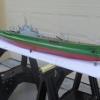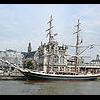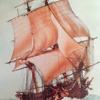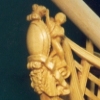Supplies of the Ship Modeler's Handbook are running out. Get your copy NOW before they are gone! Click on photo to order.
×
-
Posts
5,871 -
Joined
-
Last visited
Reputation Activity
-
 BANYAN got a reaction from EricWilliamMarshall in HMCSS Victoria 1855 by BANYAN - 1:72
BANYAN got a reaction from EricWilliamMarshall in HMCSS Victoria 1855 by BANYAN - 1:72
Hi folks, the new project. I am not the sole builder of this model which is a club project for the Ship Modelling Society of Victoria. I am coordinating the build, doing the research, drawing the plans and assisting in the build process. I am providing this log as she is an interesting ship and I thought members may be interested.
While designed as a warship along the lines of the contemporary Arrow and Vigilant Classes of Gun Dispatch vessels, she was operated in various roles, with only a very short period of active duty as a commissioned ship during the Maori Wars in New Zealand. Her Majesty’s Colonial Screw Sloop (HMCSS) Victoria was built for the defence of the Colony of Victoria during the gold rush era.
The above image is a copy of a purchased image from The Illustrated London News which shows her during her Builders Trials.
Additionally, as much of the hull construction has already been completed, I will provide a summary of this part of the build only.
-
 BANYAN got a reaction from Piet in SMS Seydlitz by Canute, Cog, Stein Gildberg & RGL - FINISHED - Hobbyboss - 1/350 - PLASTIC
BANYAN got a reaction from Piet in SMS Seydlitz by Canute, Cog, Stein Gildberg & RGL - FINISHED - Hobbyboss - 1/350 - PLASTIC
Some very fine detail there Greg, will add greatly to the model.
cheers
Pat
-
 BANYAN reacted to vossiewulf in Great Republic 1853 by rwiederrich - FINISHED - four masted extreme clipper
BANYAN reacted to vossiewulf in Great Republic 1853 by rwiederrich - FINISHED - four masted extreme clipper
I don't have OCD, I just have an uncontrollable urge to make sure everything is perfectly right and straight and aligned at all times. Totally different!
-
 BANYAN reacted to dashi in HM Bark Endeavour by dashi - Caldercraft - scale 1:64 - 1768-71 - bashed kit
BANYAN reacted to dashi in HM Bark Endeavour by dashi - Caldercraft - scale 1:64 - 1768-71 - bashed kit
Thanks for the likes, and thanks Sam, do you have a build log for your Bounty?
Updates: Jeer blocks and Corrections.
Jeer blocks: Here are the photos showing the re run of the stays around the head [as stated in previous post] along with the first jeer block lashed to the head. The strapping for the jeer block according to Steel is 5" so used 0.75 black thread doubled and made it's length 1 fathom [6ft] so the blocks sit at a nice height below the stays and above the yard. The lashing around the mast is 3" and 28 fathoms long or 14 fathoms per side until it's used up and well stopped, so used 0.25 caldercraft black cord which wasn't supplied in the kit. I basically clamped the jeer block in position with the strapping eye touch the base of the jeer cleat and held the lashing in place above the opposite cleat with my finger as I passed the cord around keeping it pulled firm and even. I will fix it all in place with diluted white glue when done.
Corrections: A major oversight of mine early on was to have the main stay collar too close in to the fore bits which resulted in the preventer stay collar around the fore mast being below the height of the stowed boats which would fowl the mid/main stay sail if used. So moved the main stay collar up the bowsprit to give enough clearance for the preventor stay and mid stay sail. Where the main stay passes the fore mast was exactly on the preventor collar cleat so filed an angle groove for the stay to rest in. Fortunately I used white glue for the collar cleats so used water to soften the glue and cleanly removed them from the mast for repositioning.
Main and fore shrouds: Before adding the jeer blocks I thought it best to review my lower rigging as I don't want to be removing them. I wasn't comfortable with the first top mast standing back stay on a large dead eye and the after standing back stay on a small dead eye on the channels, when they are both the same size rope. It seems more likely with the dead eye configuration that there was only one pair of standing back stays for the top masts on the small dead eye at the aft end of the channel, because in addition to these on the topmasts there are the breast back stay and shifting or 'weather back stay' as Cook refers to it, which still leaves 3 pair of top mast back stays. Endeavour did have problems with the top mast back stays. The sheer plan of the 'Wasp 1812 in the National Maritime Museum' http://collections.rmg.co.uk/collections/objects/84386.html which is close in size to Endeavour, seems to bear this configuration out with one pair of standing back stays for the topmasts and two pair of standing back stays to thimbles for the top gallant masts [which I will do]. So have added the extra shrouds to the fore and main masts on the large deadeyes as can be seen.
Cheers dashi
-
 BANYAN reacted to RGL in SMS Seydlitz by Canute, Cog, Stein Gildberg & RGL - FINISHED - Hobbyboss - 1/350 - PLASTIC
BANYAN reacted to RGL in SMS Seydlitz by Canute, Cog, Stein Gildberg & RGL - FINISHED - Hobbyboss - 1/350 - PLASTIC
Just to keep you entertained, these little pulleys sit on the gunnels at the bow as in the previous photos that the cables will run to the windlass from the end of the torpedo net booms.
I spent a day preparing the booms plus some pulleys to go on the boom
-
 BANYAN reacted to Beef Wellington in HMS Jason by Beef Wellington - Caldercraft - 1:64 - Artois-class frigate modified from HMS Diana 1794
BANYAN reacted to Beef Wellington in HMS Jason by Beef Wellington - Caldercraft - 1:64 - Artois-class frigate modified from HMS Diana 1794
OC, Carl, Rob, Thomas, Mike, Dave, Pat and all the likes...definitely helps keeping one moving forward!
Finally, have all the guns in position an the breeching ropes in place. Amazingly time consuming, no more need be said, and glad its behind me. I did allow myself the small concession of using a ringbolt for the less visible guns, and went with a ringbolt and ring for those visible in the waist area. Despite the latter being more 'correct', the jury is still out on whether the results totally warrant it at this scale as the eyebolts only version seems acceptable to my eye (comparison photo below). As usual, dilute PVA was used to help keep the breech ropes in position and to try give them a sense of weight. Photos seem to call attention to all the little dings and dents that seem unavoidable and thankfully not really noticeable during normal viewing.
A very simple jig was used to help keep lengths consistent. When using rings, I found that opening up a ringbolt using a small metal point and reclosing was easier, faster and predictable than opening up the ring itself.
-
 BANYAN got a reaction from Beef Wellington in HMS Jason by Beef Wellington - Caldercraft - 1:64 - Artois-class frigate modified from HMS Diana 1794
BANYAN got a reaction from Beef Wellington in HMS Jason by Beef Wellington - Caldercraft - 1:64 - Artois-class frigate modified from HMS Diana 1794
Happy New Year t you too mate.
Very (VERY) nice work on those channels, brackets and guns Jason. Those are very neatly executed brackets and look just right.
cheers
Pat
-
 BANYAN got a reaction from Rudolf in HMCSS Victoria 1855 by BANYAN - 1:72
BANYAN got a reaction from Rudolf in HMCSS Victoria 1855 by BANYAN - 1:72
Hi folks, I have made some progress on the winches, with the parts now all turned, photoetched etc. I have managed to put the ironwork (brass) for one of them together but still to add the wooden 'bed'. The photos show the progress as I went along but still a lot of cleaning up to do. Most of this is fine metal powder, but a few 'dags' here and there to fix.
The whole assembly is only 15mm long by 11mm high. The small handwheel was purchased but the rest of the parts including the larger hand wheel, except the tapered drum which I turned, are PE that I drew up and had etched. The slightly grooved effect n the drum is deliberate as it had grooves for the first turns of the wire to lay up into. I have styled this after a winch illustrated in Underhill's 'Masting and Rigging the Clipper Ship and Ocean Carrier'.
The cog wheel is two pieces of .2mm bras with tiny alignment holes which allowed me to solder them together and keep the teeth aligned. The worm gear is still beyond my skills so I simply used some brass tube (1.5 mm). The other handwheel is set into a short length of 1.0 mm tube, which is then partially inserted into some small brass square section, to represent the gear box for the drum brake, which is made from thin copper (bends more easily).
The small ding in the tapered wire drum is bigger than planned but is intend as a 'flat' to let me drill through as a starting point for the steel wire rope that will be attached. The halliards (steel wire) were bent to the winch and remained there permanently with the tension held by the drum brake. My next problem is to work out how to fit this strongly enough to allow me to create a 'little' tension on the scaled halliards without pulling the winch away from the deck.
cheers
Pat
-
 BANYAN got a reaction from Rudolf in HMCSS Victoria 1855 by BANYAN - 1:72
BANYAN got a reaction from Rudolf in HMCSS Victoria 1855 by BANYAN - 1:72
Another small update folks. This shows some of the completed parts in-situ but the 'pelorus' is only dry fitted. I have yet to add the connection point (hydrant) for the 7" fire pump between the two suction plate assemblies, and a few sounding pipes. There is also a brass (single) rail to go around this area.
Dave, the laser cut came up well; many thanks to you and your mate for organising this for me. The rod grills are made from PE verticals and .6mm brass wire/rod which I soldered at the ends (each rod) and spot soldered two rods only for the inner ones. I have rebated a length of 0.5mm brass rod into the centreline piece of the skylight to represent a 'piano style' hinge with the edges screwed off against the sides of the panels in real life.
Unfortunately the laser cut ply came up a little darker than the rest of the wood (Kauri) but I think I can live with it I have also fitted the two 'L' handles for the downton pumps against the rear end of the skylight. These were only fitted when required. The dado along the bottom is 8" (actual) which corresponds with the dado on the circular skylights (4 of, still to be made) which will be fitted two abreast between the pelorus and companion, and the other two abreast aft of the companion.
cheers
Pat
-
 BANYAN got a reaction from hexnut in HMCSS Victoria 1855 by BANYAN - 1:72
BANYAN got a reaction from hexnut in HMCSS Victoria 1855 by BANYAN - 1:72
Hi folks, I have made some progress on the winches, with the parts now all turned, photoetched etc. I have managed to put the ironwork (brass) for one of them together but still to add the wooden 'bed'. The photos show the progress as I went along but still a lot of cleaning up to do. Most of this is fine metal powder, but a few 'dags' here and there to fix.
The whole assembly is only 15mm long by 11mm high. The small handwheel was purchased but the rest of the parts including the larger hand wheel, except the tapered drum which I turned, are PE that I drew up and had etched. The slightly grooved effect n the drum is deliberate as it had grooves for the first turns of the wire to lay up into. I have styled this after a winch illustrated in Underhill's 'Masting and Rigging the Clipper Ship and Ocean Carrier'.
The cog wheel is two pieces of .2mm bras with tiny alignment holes which allowed me to solder them together and keep the teeth aligned. The worm gear is still beyond my skills so I simply used some brass tube (1.5 mm). The other handwheel is set into a short length of 1.0 mm tube, which is then partially inserted into some small brass square section, to represent the gear box for the drum brake, which is made from thin copper (bends more easily).
The small ding in the tapered wire drum is bigger than planned but is intend as a 'flat' to let me drill through as a starting point for the steel wire rope that will be attached. The halliards (steel wire) were bent to the winch and remained there permanently with the tension held by the drum brake. My next problem is to work out how to fit this strongly enough to allow me to create a 'little' tension on the scaled halliards without pulling the winch away from the deck.
cheers
Pat
-
 BANYAN got a reaction from Chasseur in Bristol Pilot Cutter by michael mott - 1/8 scale - POF
BANYAN got a reaction from Chasseur in Bristol Pilot Cutter by michael mott - 1/8 scale - POF
This will be one-stunning model Michael. I love the detail and quality of the work.
cheers
Pat
-

-
 BANYAN reacted to Omega1234 in HMCSS Victoria 1855 by BANYAN - 1:72
BANYAN reacted to Omega1234 in HMCSS Victoria 1855 by BANYAN - 1:72
Suitably gobsmacked, Pat. That’s mighty fine work!
Cheers
Patrick
-
 BANYAN reacted to wefalck in HMCSS Victoria 1855 by BANYAN - 1:72
BANYAN reacted to wefalck in HMCSS Victoria 1855 by BANYAN - 1:72
Nice piece of engineering ! I think, if you Fashion some hexagonal ‚bolts‘ from little brass nails, that should fix the winch sufficiently down on the deck.
i am surprised to see brass-winches already at that time. I thought they were only introduced in the 1880s.
-
 BANYAN reacted to cog in HMCSS Victoria 1855 by BANYAN - 1:72
BANYAN reacted to cog in HMCSS Victoria 1855 by BANYAN - 1:72
Stunning Pat. At that size ... whomever would even see the worm ... absolutely beautiful
-
 BANYAN reacted to druxey in Bristol Pilot Cutter by michael mott - 1/8 scale - POF
BANYAN reacted to druxey in Bristol Pilot Cutter by michael mott - 1/8 scale - POF
Just 'whipped up a couple more' vents? You make it sound as easy as sharpening a pencil, Michael!
-
 BANYAN reacted to michael mott in Bristol Pilot Cutter by michael mott - 1/8 scale - POF
BANYAN reacted to michael mott in Bristol Pilot Cutter by michael mott - 1/8 scale - POF
I feel the same way when I watch someone play the piano. The thing is as you know its the practice that is the key, and each piece affords a little more knowledge of the puzzle on the best way to proceed.
Michael
-
 BANYAN reacted to cog in Bristol Pilot Cutter by michael mott - 1/8 scale - POF
BANYAN reacted to cog in Bristol Pilot Cutter by michael mott - 1/8 scale - POF
That's how the modest masters always put it ...
-
 BANYAN got a reaction from albert in HMCSS Victoria 1855 by BANYAN - 1:72
BANYAN got a reaction from albert in HMCSS Victoria 1855 by BANYAN - 1:72
Hi folks, I have made some progress on the winches, with the parts now all turned, photoetched etc. I have managed to put the ironwork (brass) for one of them together but still to add the wooden 'bed'. The photos show the progress as I went along but still a lot of cleaning up to do. Most of this is fine metal powder, but a few 'dags' here and there to fix.
The whole assembly is only 15mm long by 11mm high. The small handwheel was purchased but the rest of the parts including the larger hand wheel, except the tapered drum which I turned, are PE that I drew up and had etched. The slightly grooved effect n the drum is deliberate as it had grooves for the first turns of the wire to lay up into. I have styled this after a winch illustrated in Underhill's 'Masting and Rigging the Clipper Ship and Ocean Carrier'.
The cog wheel is two pieces of .2mm bras with tiny alignment holes which allowed me to solder them together and keep the teeth aligned. The worm gear is still beyond my skills so I simply used some brass tube (1.5 mm). The other handwheel is set into a short length of 1.0 mm tube, which is then partially inserted into some small brass square section, to represent the gear box for the drum brake, which is made from thin copper (bends more easily).
The small ding in the tapered wire drum is bigger than planned but is intend as a 'flat' to let me drill through as a starting point for the steel wire rope that will be attached. The halliards (steel wire) were bent to the winch and remained there permanently with the tension held by the drum brake. My next problem is to work out how to fit this strongly enough to allow me to create a 'little' tension on the scaled halliards without pulling the winch away from the deck.
cheers
Pat
-
 BANYAN got a reaction from mtaylor in Bristol Pilot Cutter by michael mott - 1/8 scale - POF
BANYAN got a reaction from mtaylor in Bristol Pilot Cutter by michael mott - 1/8 scale - POF
This will be one-stunning model Michael. I love the detail and quality of the work.
cheers
Pat
-
 BANYAN got a reaction from EdT in HMCSS Victoria 1855 by BANYAN - 1:72
BANYAN got a reaction from EdT in HMCSS Victoria 1855 by BANYAN - 1:72
Hi folks, I have made some progress on the winches, with the parts now all turned, photoetched etc. I have managed to put the ironwork (brass) for one of them together but still to add the wooden 'bed'. The photos show the progress as I went along but still a lot of cleaning up to do. Most of this is fine metal powder, but a few 'dags' here and there to fix.
The whole assembly is only 15mm long by 11mm high. The small handwheel was purchased but the rest of the parts including the larger hand wheel, except the tapered drum which I turned, are PE that I drew up and had etched. The slightly grooved effect n the drum is deliberate as it had grooves for the first turns of the wire to lay up into. I have styled this after a winch illustrated in Underhill's 'Masting and Rigging the Clipper Ship and Ocean Carrier'.
The cog wheel is two pieces of .2mm bras with tiny alignment holes which allowed me to solder them together and keep the teeth aligned. The worm gear is still beyond my skills so I simply used some brass tube (1.5 mm). The other handwheel is set into a short length of 1.0 mm tube, which is then partially inserted into some small brass square section, to represent the gear box for the drum brake, which is made from thin copper (bends more easily).
The small ding in the tapered wire drum is bigger than planned but is intend as a 'flat' to let me drill through as a starting point for the steel wire rope that will be attached. The halliards (steel wire) were bent to the winch and remained there permanently with the tension held by the drum brake. My next problem is to work out how to fit this strongly enough to allow me to create a 'little' tension on the scaled halliards without pulling the winch away from the deck.
cheers
Pat
-
 BANYAN got a reaction from Piet in Bristol Pilot Cutter by michael mott - 1/8 scale - POF
BANYAN got a reaction from Piet in Bristol Pilot Cutter by michael mott - 1/8 scale - POF
This will be one-stunning model Michael. I love the detail and quality of the work.
cheers
Pat
-
 BANYAN got a reaction from popeye the sailor in HMCSS Victoria 1855 by BANYAN - 1:72
BANYAN got a reaction from popeye the sailor in HMCSS Victoria 1855 by BANYAN - 1:72
Hi folks, I have made some progress on the winches, with the parts now all turned, photoetched etc. I have managed to put the ironwork (brass) for one of them together but still to add the wooden 'bed'. The photos show the progress as I went along but still a lot of cleaning up to do. Most of this is fine metal powder, but a few 'dags' here and there to fix.
The whole assembly is only 15mm long by 11mm high. The small handwheel was purchased but the rest of the parts including the larger hand wheel, except the tapered drum which I turned, are PE that I drew up and had etched. The slightly grooved effect n the drum is deliberate as it had grooves for the first turns of the wire to lay up into. I have styled this after a winch illustrated in Underhill's 'Masting and Rigging the Clipper Ship and Ocean Carrier'.
The cog wheel is two pieces of .2mm bras with tiny alignment holes which allowed me to solder them together and keep the teeth aligned. The worm gear is still beyond my skills so I simply used some brass tube (1.5 mm). The other handwheel is set into a short length of 1.0 mm tube, which is then partially inserted into some small brass square section, to represent the gear box for the drum brake, which is made from thin copper (bends more easily).
The small ding in the tapered wire drum is bigger than planned but is intend as a 'flat' to let me drill through as a starting point for the steel wire rope that will be attached. The halliards (steel wire) were bent to the winch and remained there permanently with the tension held by the drum brake. My next problem is to work out how to fit this strongly enough to allow me to create a 'little' tension on the scaled halliards without pulling the winch away from the deck.
cheers
Pat
-
 BANYAN got a reaction from DORIS in HMCSS Victoria 1855 by BANYAN - 1:72
BANYAN got a reaction from DORIS in HMCSS Victoria 1855 by BANYAN - 1:72
Hi folks, I have made some progress on the winches, with the parts now all turned, photoetched etc. I have managed to put the ironwork (brass) for one of them together but still to add the wooden 'bed'. The photos show the progress as I went along but still a lot of cleaning up to do. Most of this is fine metal powder, but a few 'dags' here and there to fix.
The whole assembly is only 15mm long by 11mm high. The small handwheel was purchased but the rest of the parts including the larger hand wheel, except the tapered drum which I turned, are PE that I drew up and had etched. The slightly grooved effect n the drum is deliberate as it had grooves for the first turns of the wire to lay up into. I have styled this after a winch illustrated in Underhill's 'Masting and Rigging the Clipper Ship and Ocean Carrier'.
The cog wheel is two pieces of .2mm bras with tiny alignment holes which allowed me to solder them together and keep the teeth aligned. The worm gear is still beyond my skills so I simply used some brass tube (1.5 mm). The other handwheel is set into a short length of 1.0 mm tube, which is then partially inserted into some small brass square section, to represent the gear box for the drum brake, which is made from thin copper (bends more easily).
The small ding in the tapered wire drum is bigger than planned but is intend as a 'flat' to let me drill through as a starting point for the steel wire rope that will be attached. The halliards (steel wire) were bent to the winch and remained there permanently with the tension held by the drum brake. My next problem is to work out how to fit this strongly enough to allow me to create a 'little' tension on the scaled halliards without pulling the winch away from the deck.
cheers
Pat
-
 BANYAN got a reaction from michael mott in Bristol Pilot Cutter by michael mott - 1/8 scale - POF
BANYAN got a reaction from michael mott in Bristol Pilot Cutter by michael mott - 1/8 scale - POF
This will be one-stunning model Michael. I love the detail and quality of the work.
cheers
Pat


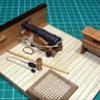
.thumb.jpeg.fc5d633a7b34428fcf19419a73d56d55.jpeg)
